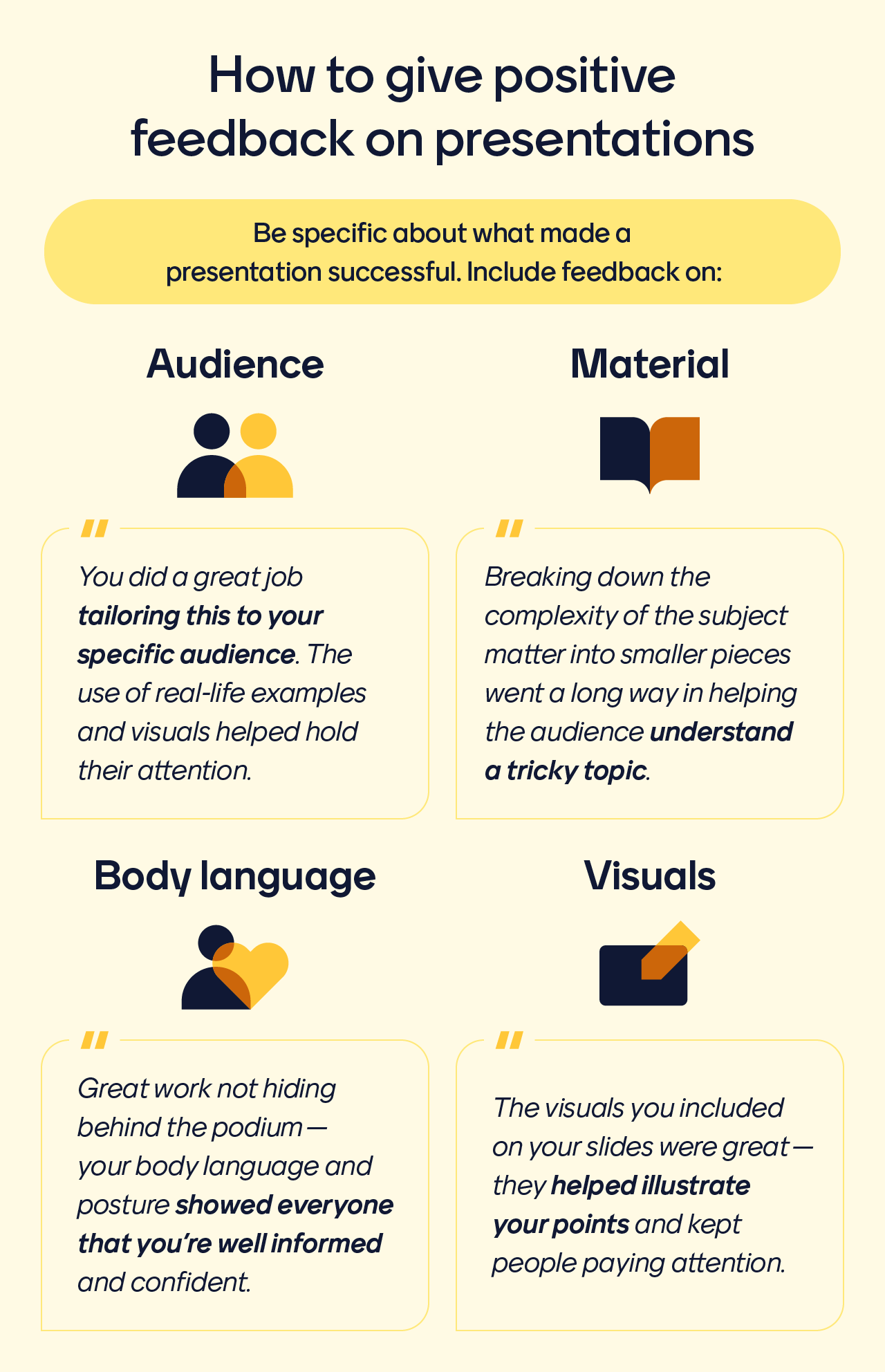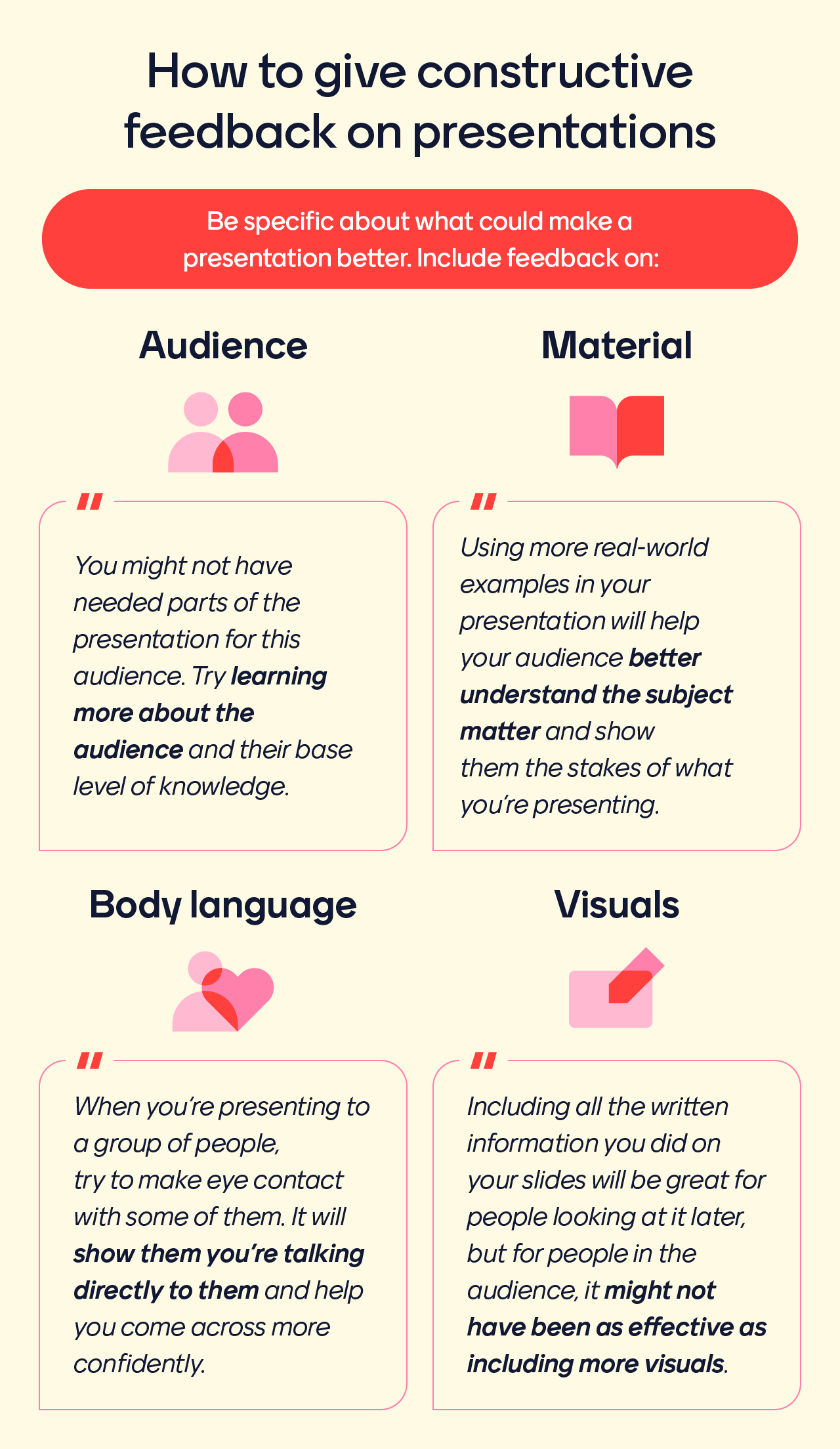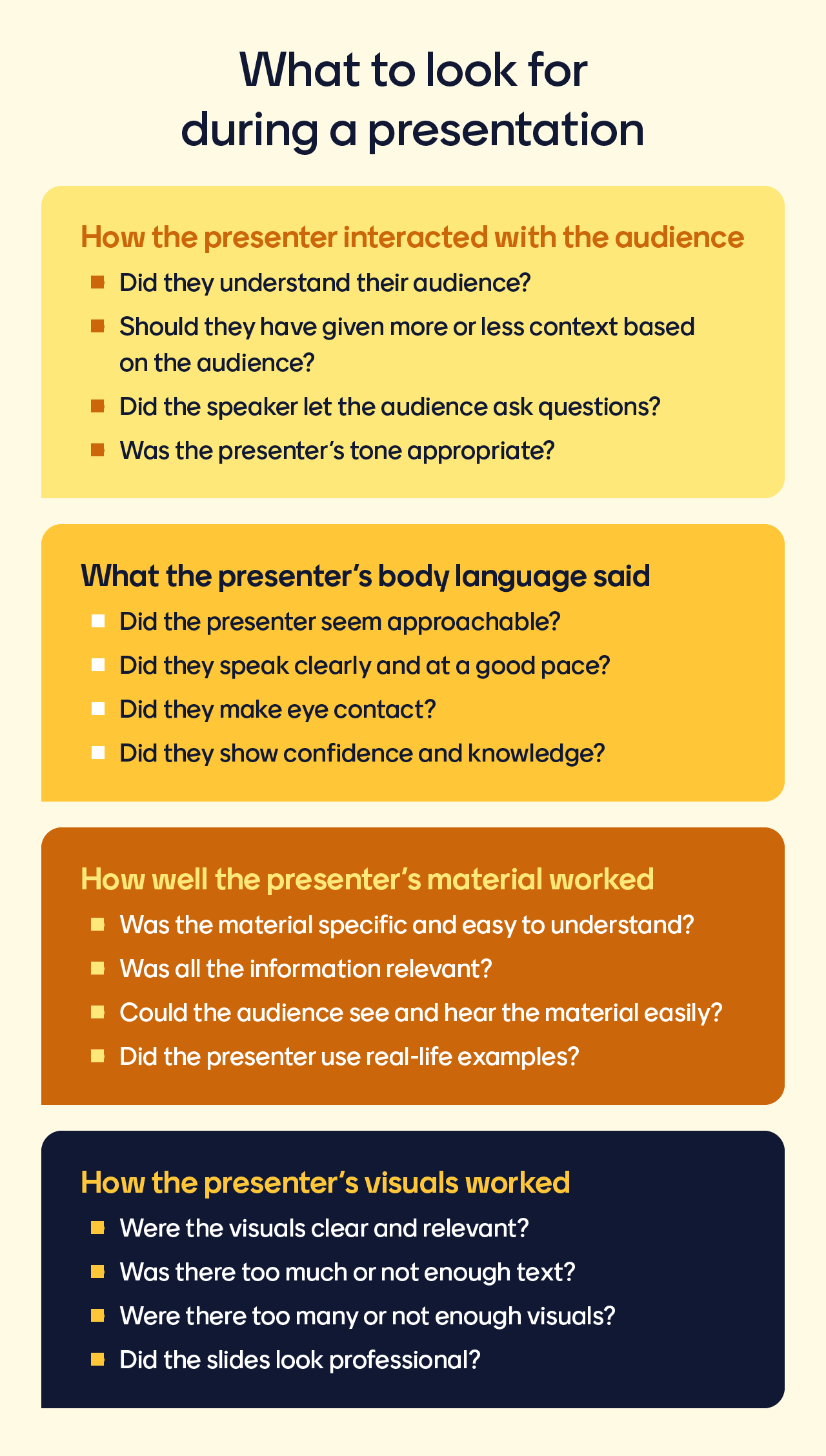27 presentation feedback examples for more engaging speakers

Learning how to give a good presentation isn’t a talent, it’s a skill. And that means it takes time and repetition to get better at it. The same is true for giving feedback.
If you’re a manager or leader, your feedback can help dramatically improve a presenter’s future performance and bolster their confidence.
Continuous improvement starts with consistent feedback. We compiled a list of presentation feedback examples to serve as a starting point for delivering feedback, whether it’s glowing or constructive.
While feedback may be part of your daily job, encourage your team to collect feedback proactively with this list of feedback survey templates that take the legwork out of gathering feedback.
Types of feedback
Feedback comes in two main forms: positive (also called reinforcing ) and constructive (or redirecting ). Because you’ll probably give some of each type in a presentation review, let’s look at the main differences and some examples of when to apply each.
Positive feedback
What it is: Positive feedback focuses on what the presenter did right. It should:
- Call attention to the speaker’s strengths
- Give specific examples of what worked well
When to give it: Give positive feedback about as many parts of the presentation as you can. While you don’t need to go line by line or slide by slide, call out specific moments that went well beyond what was expected or what is “good enough.”
Constructive feedback
What it is: Constructive feedback focuses on the areas that need improvement. As the name suggests, this type of feedback is about building up, not tearing down, so always include advice on how to avoid those issues in the next project.
This kind of feedback is about calling attention to the weaknesses of a particular presentation and not to the presenters themselves.
When to give it: Give constructive feedback wherever it’s needed. If you see a problem across an entire presentation, give a few examples instead of calling out every instance. It can also help to ask the presenter questions about their thought process before sizing up their slides or speech so you can see where their knowledge gaps are.
Positive presentation feedback

Giving positive feedback on a presentation seems like it should be pretty easy — the presenter did a good job, right? But good feedback is about being specific. Instead of saying, “Great work!” tell the presenter about how well the content fit the audience, how their slides reinforced what they said, and how their body language and delivery helped drive home their points.
Here are some examples of specific, positive feedback you can give to a presenter when they’ve really nailed it:
- The flow of your presentation made sense and helped the audience understand the depth of the topic.
- You went above and beyond with the research on this presentation. Your stats and figures really showed how prepared you were.
- Including slides about [subject] proved to the audience that you understood their viewpoints and concerns.
- Your icebreaker was great because it was attention-grabbing and helped you show off your authority.
- Breaking down the complexity of the subject matter into smaller pieces went a long way in helping the audience understand a tricky topic.
- The real-life examples you used showed how relevant the topic is to your audience.
- The visuals you included on your slides were great — they helped illustrate your points and kept people paying attention.
- Good job including spots throughout the presentation where people could ask questions — that cleared up the confusion and helped the audience stay engaged.
- The way you spoke to the audience was professional but passionate and interesting.
- The way you concluded the presentation was excellent — it helped wrap things up while inviting the audience to learn more.
- Your overall attention to detail, from how you laid out your slides to how you spoke to the audience, made your presentation more powerful and memorable.
- Great work not hiding behind the podium — your body language and posture showed everyone that you’re well informed and confident.
- Including links to further reading on some of the more complex topics was a great idea, especially for people who aren’t as familiar with the topic.
Constructive presentation feedback

When giving feedback on a presentation that didn’t quite hit the mark, think about it as a way of helping the presenter get better for next time. Remember, the more specific and clear you are with your evaluation, the more the speaker can learn how to give a better presentation.
Here are some examples of constructive feedback you can use:
- Think about what will grab the audience’s attention right away, like a thought-provoking question or an interesting statistic, and lead with that.
- I think it’s important to try to make eye contact with some of them. It’ll show them you’re talking directly to them and help you seem more confident.
- Work on speaking as clearly as you can and at a slower pace to help your audience keep up with you. Check out some resources online that can help you level up your public speaking skills.
- Try speaking at about half the speed you normally would, record it, and listen back. You’ll probably hear that you sound more confident and natural.
- Try including some time after certain parts of the presentation for the audience to ask questions. Or have a response for surprise questions — it’s okay to say you’ll be happy to take questions at the end.
- You might not have needed parts of the presentation for this audience. If you aren’t sure if you should leave something in, try learning more about who the audience is and where their base level of knowledge is.
- I feel like the layout of your presentation was a little confusing because it moved back and forth between the general and the specific. Try starting very general and getting more and more specific.
- While there may not be a perfect transition between all slides, you can include a sentence or two in your notes to help the audience understand that you’re shifting to a new topic.
- I think that using more real-world examples in your presentation will help your audience better understand the subject matter and show them the stakes of what you’re presenting.
- Including all the written information you did on your slides will be great for people looking at it later, but I feel like it might not have been as effective as including some more visuals.
- Using humor and GIFs in your slides can be a great way to connect with an audience, but make sure they aren’t overpowering the information. Maybe try using GIFs to help with transitions instead of placing them on informational slides.
- Explaining these concepts to a more general audience is always tough. It might help to give a little more context to help people with less firsthand knowledge grasp the big ideas.
- Your confidence and knowledge are great, but having a script or outline to keep you on track can shorten your presentation and help with pacing.
- Don’t be afraid to ask for help before you present. I can give you feedback on a run-through before you do it in front of others. The extra practice can make the real deal easier.
What to look for when providing feedback

Even a simple, short presentation can give an evaluator a lot to digest, and it can be tough to give feedback if you don’t know where to start. These four categories will help guide you when you’re evaluating a presentation:
- Did the presenter understand who their audience was?
- Could the speaker give more or less context based on the audience?
- Did the speaker give the audience a chance to ask questions?
- Was the tone of the presentation appropriate for the audience?
- Was the presenter approachable?
- Was the presenter speaking clearly and at a good pace?
- Did the presenter make eye contact with the audience?
- Did the presenter hide from the audience, or did they show confidence?
- Did the presenter use appropriate nonverbal cues?
- Was the material clear and specific?
- Was the information relevant?
- Was the material easy to understand?
- Did the presenter include real-world examples?
- Did the presenter include relevant visuals?
- Were the visuals easy to see and understand?
- Did the deck have too much text and not enough visuals (or vice versa)?
- Did the slides look professional?
Create a checklist or use these presentation evaluation examples to make tracking strengths and areas for improvement easier.
Tips for giving effective presentation feedback
Just like presenting, giving feedback is a skill that takes practice to master. Because every presentation is different, the specific feedback you give will vary, but the following tips can give you a framework for organizing your thoughts and communicating constructive and positive responses to a presenter.
- Give “feedback sandwiches” to presenters: A feedback sandwich begins with something positive, then something constructive, then another positive. This structure shows the presenter that you noticed what went well instead of focusing only on what wasn’t perfect.
- Give concrete and specific examples in your feedback: Use specific examples from the presentation when you’re giving constructive or positive feedback.
- Use "I" statements when giving feedback: Even if you’re an expert in presenting, any feedback you give is still an opinion. Using phrases like “I think that…” or “I felt like…” shows the speaker that you aren’t making accusations.
- Use the information to make feedback more specific: Collecting comments from others can be a huge help when you’re coaching someone after a presentation. You can use Mentimeter to collect feedback from internal and external audiences to guide your response.
- Balance positive and constructive feedback: For most people, it helps to start with some positive feedback before jumping into constructive criticism. Telling the speaker about what they did well can give them the boost they need to work on improving.
- Focus on behavior, not personality: Don’t talk about how the presenter’s personality impacted their speech. Make your feedback about the actions they took as they presented.
- Offer solutions or suggestions: Calling out everything someone did poorly without offering advice to get better results next time isn’t helpful. Remember that constructive feedback is about improvement, not punishment.
- Give feedback immediately: Details have a way of getting forgotten over time. Prompt feedback means that the pros and cons of a presentation are fresh for you and the presenter.
- Think about where you deliver feedback: Most feedback, even positive feedback, is best done in a safe, private place. If the presenter feels comfortable, they’ll be more receptive to what you have to say.
- Ask the presenter for an opinion on their performance: Asking the presenter for their thoughts on the presentation, the audience, and the overall experience can show you what their strengths are and what they identify as areas for improvement. Tailor your feedback to those areas.
- Call out the impact of the presentation: If something good happened because of a presentation, share it with the presenter. When they understand how their actions impact your team, it can help create lasting, positive change.
- Always follow up: When you give constructive feedback, include specific things the presenter should do to level up. Then, check in with them to see what kind of progress they’re making and if they need extra help. If you collected feedback about a speaker after a conference, share some wins!
Keep improving with Mentimeter
Now that you have dozens of presentation feedback examples to reference, use Mentimeter to take your feedback a step further. You can find sample meeting agendas and presentation templates to help build better presentations and use the survey features to collect comments and critiques from presentations.





